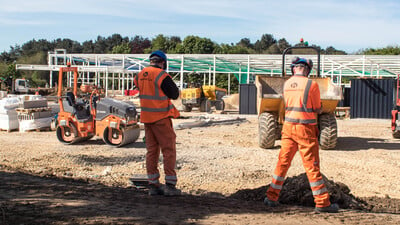One self-employed builder in Kent discovered this to his cost when he hit an underground mains power cable while excavating a hole for a fence post.
Power cable strike risked life and caused major outage
In September 2023, news website KentOnline reported that Mark Staples was working at his sister’s house near Swanley on 1st December 2022 when the incident happened. He was digging a hole for a fence post to replace a damaged garden wall and was using a Kango breaker to dig through some footings when he hit an 11,000-volt mains power cable.
As a builder, Mark would have been aware of the potential danger but several factors gave a false impression that he would be safe.
- The property is powered by overhead cables, so he had no reason to believe there might also be an underground mains electricity supply.
- There was no hazard warning tape around the cable to alert him of its presence.
- The cable wasn’t buried very far below the surface- just over a foot deep.
Confident that he would be safe, Mark drilled through the footings and hit the cable. There was a loud bang, flames and smoke and the deafening sound of electricity buzzing” Mark recounted. A large chunk of metal was missing from the tip of the breaker bit. Thankfully, the breaker had plastic handles and it’s believed these saved his life.
Damage to the high voltage underground cable also interrupted the power supply to 1,368 premises in the area for the ten hours it took for engineers to repair the damage.
A costly mistake
More than six months later, Mark received an invoice from UKPN for £24,000, claiming that he was at fault, including “failure to adhere to the safe working practices outlined by the Health and Safety Executive in their publication HS(G)47 Avoiding Danger from Underground Services.” This publication covers all underground services as well as mains electricity, so is a useful guide.
As we write, Mark is contesting the invoice and it remains to be seen whether this will be successful, but in the meantime, let’s look at what could and should have been done to avoid this incident.
Preventing damage to underground services
Whether or not UKPN may be justified in pursuing Mark for the cost of repairing and restoring the power supply, the incident highlighted several other factors that could have prevented it.
Ensure services are laid at the correct depth
According to the HSE, underground cables are generally laid 450-1000 mm below the surface. Given that Mark had only excavated just a little deeper than 300 mm, the cable must have been on the higher end of these limits.
Place a clear warning of the presence of services
Mark said that there was no hazard warning tape around the cable to alert him it was there. Cables aren’t easy to see when they are covered with earth, particularly if the earth is damp and sticky so that it clings to the cable. Hazard warning tapes are made from highly visible coloured plastic tape and feature a printed warning to alert contractors of what the cable or pipe contains.
At Drainfast, we stock a wide range of underground warning tapes for the protection of all buried services including electrical mains cables, telephone cables, traffic signal cables, optical fibre, water and gas pipes. Our range also includes detectable underground warning tapes which contain a metal strip that is detectable by a CAT scanner.
Another way to physically protect services is to place a layer of tiles or slabs above the pipe or cable. Combining this with underground warning tape will give double protection.
Don’t take anything for granted
While it seemed logical that the presence of an overhead power supply would mean there would be no buried cables, on reflection Mark would have been wiser to have not made that assumption.
He also assumed that as the hole wasn’t deep it would be too shallow to encounter any cables. And while he found no evidence of underground warning tape, in their guidance HSE comments that tiles, slabs and warning tapes can move or be disturbed.
Use more than one checking method
UKPN advises using a CAT – cable avoidance tool – to scan the area for live power cables. However, this isn’t a failsafe method and sometimes misses cables so it’s advisable to combine it with other measures.
- Request plans from utility companies to help locate underground services and apparatus.
- Take care when using tools to excavate, as power tools and even sharp hand tools can quickly penetrate unprotected cables.
We hope you have found this information helpful and interesting. If you have any further questions, you are always welcome to call the friendly team of drainage experts at Drainfast on 01420 555600 or email [email protected].
Also, look out for more articles in our ongoing series of blog posts, bringing you useful information, insights, guides and tips on all things drainage!

Written by
Mark Chambers
Marketing Manager
As Marketing Manager, Mark plays an active role in running strategic projects to increase our brand profile.

